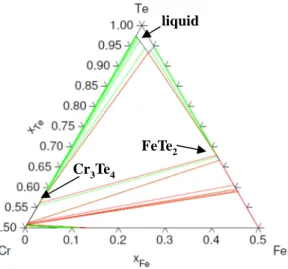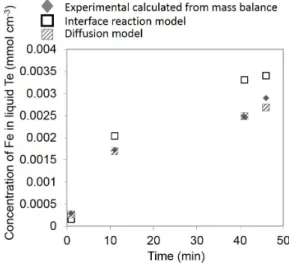HAL Id: cea-02400183
https://hal-cea.archives-ouvertes.fr/cea-02400183
Submitted on 9 Dec 2019
HAL is a multi-disciplinary open access
archive for the deposit and dissemination of
sci-entific research documents, whether they are
pub-lished or not. The documents may come from
teaching and research institutions in France or
abroad, or from public or private research centers.
L’archive ouverte pluridisciplinaire HAL, est
destinée au dépôt et à la diffusion de documents
scientifiques de niveau recherche, publiés ou non,
émanant des établissements d’enseignement et de
recherche français ou étrangers, des laboratoires
publics ou privés.
Corrosion in liquid metals from database acquisition to
life time prediction
L. Martinelli, M. Roy, D.J. Young, S. Gosse, S. Bosonnet
To cite this version:
L. Martinelli, M. Roy, D.J. Young, S. Gosse, S. Bosonnet. Corrosion in liquid metals from database
acquisition to life time prediction. International Symposium on High-Temperature Oxidation and
Corrosion (ISHOC - 2018), Oct 2018, Matsue, Japan. �cea-02400183�
Corrosion in liquid metals: from database acquisition to life time prediction
L. Martinelli (1,*), M. Roy (2), D. J. Young (3), S. Gossé (1), S. Bosonnet (1)
(1) CEA, DEN, Service de la Corrosion et du Comportement des Matériaux dans leur Environnement (SCCME), CEA,
Université Paris-Saclay, F-91191, Gif-sur-Yvette, France
(2) CEA, DEN, Service d’Etude du Comportement des Radionucléides (SECR), CEA, Université Paris-Saclay, F-91191,
Gif-sur-Yvette, France
(3) School of Materials Science & Engineering, University of New South Wales, Sydney, Australia
e-mail: laure.martinelli@cea.fr
1. INTRODUCTION
In nuclear power plant, materials can be corroded by liquid metals that are either flowing as coolant in first and secondary circuit (lead alloys: Pb-Bi) or stagnant as fission product in cladding (tellurium). Steel corrosion process depends: (i) on the concentration of dissolved corrosive element as O or C that can lead to oxidation or carburization, similarly to corrosion processes in gas phase; (ii) on the potential existence of
intermetallic containing elements originating from both liquid metal and steel (FeTe2, Cr3Te4); (iii) on capability of steel dissolution in
the liquid metal. For all these corrosion processes, thermodynamic databases have to be developed in order to model the corrosion mechanisms. The obtained corrosion model is supposed to be used for life time prediction. This paper deals with both thermodynamic data acquisition (Ni solubility limit in liquid lead bismuth alloy) with thermodynamic database development (Calphad method) and corrosion experiments with mechanism modelling. Liquid metal environment considered are liquid Te and Pb-Bi alloy. Corroded steels are austenitic steels.
2. EXPERIMENTAL
Corrosion experiments are carried out in stagnant liquid metal conditions in crucible in glove box at 500°C and 551°C for respectively Pb-Bi alloy and pure Te. Ar or Ar-H2 gas are sweeping
over the liquid metal to avoid steel oxidation. Samples dimensions are 30x10x(0.5 or 1) mm. Two experimental techniques have been implemented for the determination of the nickel solubility limit in Pb-Bi at low temperatures. The first one is performed from 400°C to 500°C using Laser Induce Breakdown Spectroscopy (LIBS). The LIBS technique permits to obtain in situ measurements directly performed on liquid Pb-Bi. It allows to monitor on line the concentration of the dissolved impurities in the liquid coolant. However, this technique is still under development and optimization for liquid media. The second technique is ICP-AES. It is commonly used to analyse alloys composition. It permits a very reliable analyse of a Pb-Bi sample. However, ICP-AES analysis is ex-situ. The investigated temperatures for nickel solubility limit measurement via ICP-AES ranges from 350°C to 535°C. For technical reasons, the experiments could not be performed above 535°C.
3. RESULTS AND DISCUSSION 3.1. Thermodynamic data acquisition
-2.1 -1.9 -1.7 -1.5 -1.3 -1.1 -0.9 -0.7 0.001 0.0015
Fig 1: measured and calculated solubility
limit (Calphad method) of Ni in Pb-Bi alloy [1-4] [3] [2] [1] [4] lo g10 SN i (a t. fr a c) 1/T (K-1)
Fig 2: Te rich domain of the ternary
Te-Cr-Fe phase diagram calculated at 550°C (Calphad method)
Cr3Te4
FeTe2 liquid
Ni solubility limit has been measured in Pb-Bi eutectic and then compared to literature data (Fig 1.) [1,2]. The solubility limit law, obtained for the highest temperatures, is in agreement with the literature data [3,4] for the same temperature range.
In this study, a change of slope in the solubility limit law (Fig 1) is obtained at lowest temperatures. In order to better predict the metals (Cr-Fe-Ni) solubilities at equilibrium, thermodynamic modelling has been performed using the Calphad method [2]. According to this modelling, the Ni solubility exhibit a change of slope due to the precipitation of BiNi intermetallic at low temperature (instead of FCC-Ni at higher temperature).
For corrosion in pure Te, Cr-Te and Fe-Te binaries have been modelled [5]. The ternary phase diagram Cr-Fe-Te is calculated by extrapolation of these binaries. To predict the phases at equilibrium, the isothermal Cr-Fe-Te cross section is calculated in the Te rich domain (Fig 2). The diagram is plotted at 550°C that is the temperature of interest for corrosion experiments. Results show the presence of a three phase domain where liquid Te equilibrates with two Cr-Te and Fe-Te intermetallics: Teliq + Cr3Te4 + FeTe2.
3.2. Corrosion tests and modelling
Corrosion of 316L in liquid Pb-Bi with low oxygen concentration leads to pure dissolution of the steel. However the dissolution is not congruent. Preferential dissolution of Cr and Ni leads to phase transformation from austenite to ferrite of 316L in contact with Pb-Bi (Fig 3). For all tested austenitic alloys, corrosion kinetics are linear and Cr dissolution rates have been measured and are presented as a function of Cr activity of steels in Fig 4. It shows that the Cr dissolution rate is proportional to the Cr activity in the steel. In order to determine the corrosion mechanism, the corrosion rate has been modelled considering that it is controlled by diffusion of dissolved Cr across the diffusion boundary layer generated by natural convection of the
liquid metal. Fig 4 shows that the calculated corrosion rate is also proportional to the steel Cr activity and approximately twice the experimental one. Then diffusion of Cr in diffusion boundary layer could control the corrosion rate of the various studied austenitic steels.
0 10 20 30 40 50 60 70 80 90 100 0 2 4 6 8 10 12 14 16 18 20 0,0 0,2 0,4 0,6 0,8 T e n e u r e n C r e t N i (a t% ) Te n e u r e n F e e t P b ( a t% ) Position (µm) Cr Ni Fe Pb Couche 316 Pb Distance (µ m) C r, N i co n te n t (a t% ) F e, P b c o n te n t ( at % )
Fig 3: TEM-EDX profile of 316L sample
corroded 1470 h in Pb-Bi at 500°C. Ferritic layer 0.0E+00 5.0E-07 1.0E-06 1.5E-06 2.0E-06 2.5E-06 3.0E-06 3.5E-06 4.0E-06 0.3 0.32 0.34 0.36 0.38 0.4 D is so lu ti o n r a te o f C r (m o l m -2 s -1 ) Austenitic steels 316L 316L Austenitic steels model experiment = 2.2 10−5 − 5.1 10−6 = 1.3 10−5 − 3.9 10−6
Fig 4: experimental and modelled corrosion rate of
For corrosion of 316L in pure Te, thermodynamics (Fig 2) forecasts formation of two intermetallic phases as Cr3Te4 and
FeTe2. Indeed, EDX map of Fig 5 shows that a Te-Cr layer is formed at the 316L/Te interface. This layer is topped by a
complex mixed Cr-Fe-Ni-Te intermetallic layer. However all phases have (Fe,Ni,Cr)Te2
stoichiometry. During cooling, solidification of Te led to precipitation of several Cr-Ni-Fe-Te intermetallics as (Fe,Ni,Cr)Te2
phases (Fig 5). The corrosion rate of 316L is mainly due to congruent dissolution of the steel. The adherent intermetallic layer seems
porous. Model of this corrosion rate has been done considering that: (i) the corrosion rate is controlled by the reaction rate of iron dissolution; (ii) the corrosion rate is controlled by diffusion of iron in liquid Te. Calphad method used to fit experimental data from literature (Fig 2. Part 3.1) permitted to obtain better estimation of the iron solubility limit used in the two models. In Fig 6, both models are fitted on experimental concentration of dissolved Fe coming from corrosion of 316L. From these two fits, the diffusion coefficient of Fe in Te (diffusion model) and the apparent reaction rate constant (interface reaction model) are obtained and equal to, respectively: 10-5 cm2 s-1 and 7x10-4 s-1. The obtained diffusion
coefficient agrees with the usual values of diffusion coefficients in liquid. Moreover this model presents a better fit on experimental results. On this basis, it is concluded that Fe diffusion in the liquid Te controls the 316L corrosion rate.
4. CONCLUSION
Determination of thermodynamic and kinetic database are necessary in complex media as liquid metals. They are used in
mathematics model, firstly to discriminate the possible corrosion mechanisms and secondly to evaluate the life time of components. In this study, corrosion of 316L and other austenitic steels (for corrosion in Bi) in stagnant pure Te and Pb-Bi alloy seem to be controlled by the diffusion of dissolved species in the liquid.
References
[1] L. Martinelli, F. Vanneroy, J.C. Diaz Rosado, D. L’Hermite, M. Tabarant, J. Nucl. Mater 400 (2010) 232–239 [2] S. Gossé, Journal of Nuclear Materials 449 (2014) 122–131
[3] P.N.Martynov, K.D.Ivanov, Proceedings of four technical meeting held between dec 1995 and apr 1998, (1998) 177-184
[4] G.Rosenblatt, J.R.Wilson, Proceeding of the Session IV on corrosion by liquid metals of the 1969 Fall Meeting of the Metallurgical Society of AIME (1969), Philadelphia, Pensylvania, 469-477
[5] C-M Arvhult, C. Guéneau; S. Gossé; M. Selleby, submitted to Journal of Alloys and Compounds, 2018
Fig 5: SEM-QBSD image of cross section of 316L after immersion in the melt for
30 min.
(a) QBSD image (b) Fe and Cr map (c) Te map
Fig 6: calculated concentration of experimentally dissolved Fe from mass balance for various corrosion time; corresponding models considering a control by interface reaction rate or by Fe diffusion in liquid Te.


